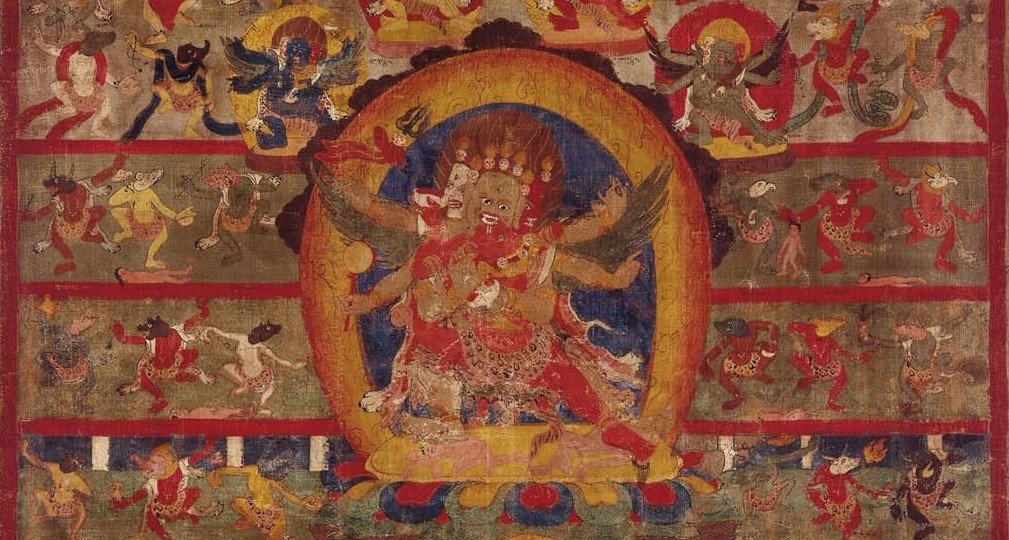 I am travelling with this mystique myself, I know. It has grown out of childhood, and adolescent reading. This looking-glass Tibet is a realm of ancient learning lost to the rest of the world, rules by a lineage of monks who are reincarnations of divinity. Recessed beyond the greatest mountain barrier on earth, in plateaux of cold purity, it floats in its own time. It is a land forbidden to intruders not by human agency but by some mystical interdiction. So it resonates like the memory of something lost, a survival from purer time, less a country than a region in the mind. Perhaps it holds the keys to the afterlife.
I am travelling with this mystique myself, I know. It has grown out of childhood, and adolescent reading. This looking-glass Tibet is a realm of ancient learning lost to the rest of the world, rules by a lineage of monks who are reincarnations of divinity. Recessed beyond the greatest mountain barrier on earth, in plateaux of cold purity, it floats in its own time. It is a land forbidden to intruders not by human agency but by some mystical interdiction. So it resonates like the memory of something lost, a survival from purer time, less a country than a region in the mind. Perhaps it holds the keys to the afterlife.
The source of these imaginings is a complex one. The tiny handful of early European travellers to Tibet brought back contradictory records, portraying a land of faith and squalor, ruled by a lama elite at once oppressive and benign. Morality coexisted confusingly with idleness and rank superstition. As Tibet’s Buddhist isolation deepened into the nineteenth century, infected by Chinese xenophobia and an isolationist Nepal, Europeans could enter it only by subterfuge, often in disguise. The few who did so created a country – refracted through Victorian eyes – peopled by pious primitives steeped in magic and sexual depravity (polyandry was rife) and so perverse that the only wheels they permitted were those for generating prayer.
Then, towards the end of the century just as European scholarship began to grapple with a more porous Tibet, a cloud of spiritual expectancy brewed up. It took bizarre forms. The notorious Madame Blavatsky, founder of the Theosophical Society, claimed guidance from a lost Atlantean kingdom in Tibet – a brotherhood later exposed as nonexistent. Soon Tibet was rumoured a laboratory of occult miracles, where the paranormal was studied as a science. Its monks performed prodigies of telepathy and sonic power, moving rocks by their voices alone. Its yogis levitated and flew. Its statues spoke. The lung-pa, ‘wind men’, after extremes of meditation, could speed like ghosts across the landscape, barely touching the ground. And all through the land were hidden sacred and prophetic texts, buried by great masters centuries before, to be unearthed only when the time was ripe. The country’s mystique touched even Rudyard Kipling’s Kim; and when Conan Doyle was forced by public demand to resurrect Sherlock Holmes from the dead, he opted for Tibet as the country in which Holmes might temporarily but convincingly have disappeared.
The fantasy of Tibet as an exalted sanctuary continued far into the twentieth century, and has never quite stilled. The country’s religion, which Victorians had considered a distant and decadent deviation from the Buddha’s truth, was gradually hailed, on the contrary, as the refined pinnacle of a developed faith, and its scriptures as a treasure house embalmed by Tibet’s isolation. The sense of a miraculously preserved past was crucial to the myth. The country had a dreamlike quality, as if time had stopped. Travellers might feel themselves re-entering childhood, or an innocent and unruly unconscious. Others likened the voyage through Tibet, for all its mountain fastness, to a descent into the underworld, and the burgeoning popularity of The Tibetan Book of the Dead, variously translated, shed its strangeness even on my own journey.
As the West reeled in disillusion through two world wars, the last strictures on Tibet faded away. It became a site of pure human longing. The name Shangri-La had entered the language through the mythic Tibetan utopia of James Hilton’s novel Lost Horizon, published in 1933, whose seers would redeem the world after its self-destruction. And something of this millennial yearning went on clinging to the country, shadowed by a foreboding at its fragility once it was exposed to the outer world.







